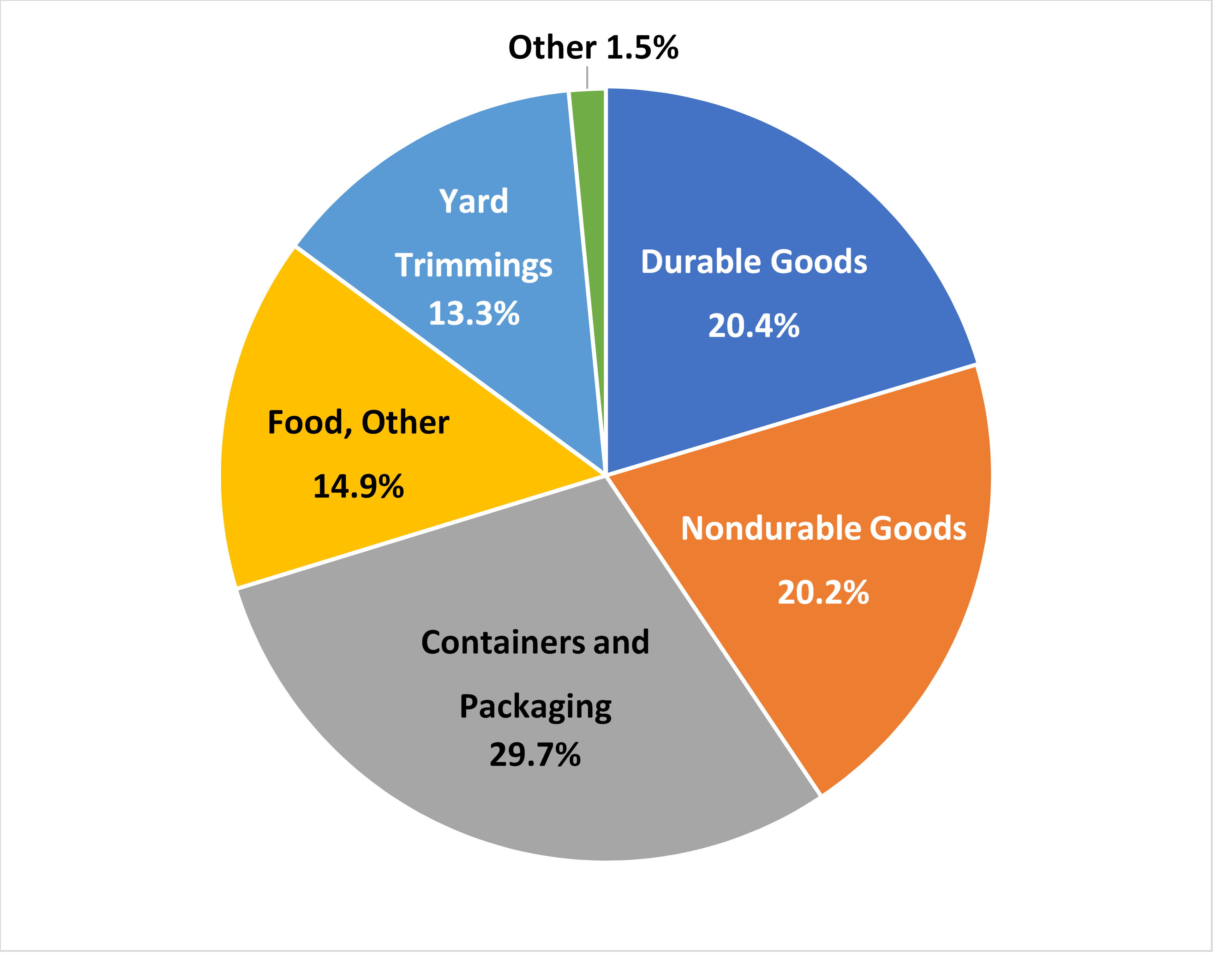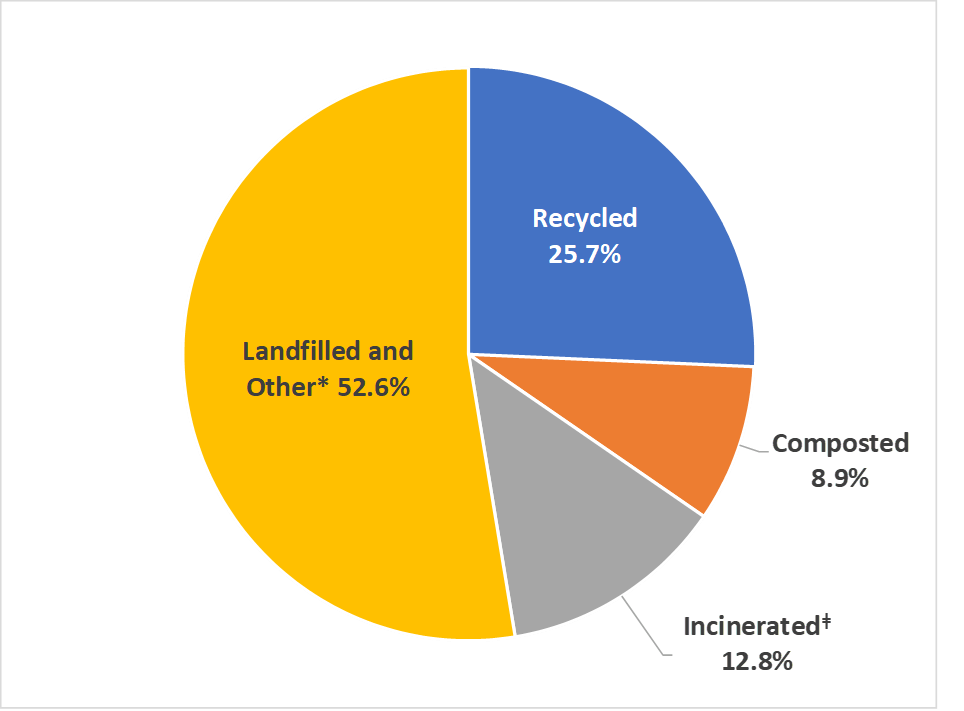Note: A newer edition of this report is available. Click here.
The United States produces an immense amount of waste.
Natural resources are continually extracted to produce goods that are used in the U.S. – often only briefly – before they are thrown into landfills, incinerators or the natural environment. This system of consumption and disposal results in the waste of precious resources and pollution that threatens our health, environment and global climate.
Because the costs of this system fall on society at large – not on the producers and consumers that drive it – there are few direct incentives for change.
To protect public health and the environment, conserve natural resources and landscapes, and address the mounting crisis of global warming, America should move toward an economic system characterized by zero waste. To achieve that goal, federal, state and local governments should enact policies and programs that incentivize shifting to a “circular,” or “closed-loop,” economy in which less is consumed and all materials are reused, recycled and composted in a continuous cycle.
The U.S. produces more than 30 percent of the planet’s total waste, though it is home to only 4 percent of the world’s population. In 2014 alone, the U.S. threw out over 258 million tons of “municipal solid waste,” or trash discarded by homes, businesses and institutions, such as universities and libraries. A Columbia University study estimates that Americans throw out 7 pounds of materials per person every day – that’s 2,555 pounds of materials per American every year. Those materials make up only 3 percent of all solid waste in America – the vast majority is generated by industrial processes such as mining, manufacturing and agriculture.
America’s garbage largely consists of goods that are used only briefly.
- About 30 percent of all U.S. “garbage”[*] is packaging, which is of little use to consumers and is typically thrown out after a product is purchased.
- Nondurable goods, such as clothing and newspaper, account for an additional 20 percent of U.S. garbage, with yard trimmings (13.3 percent) and food and other organic materials (14.9 percent), accounting for a substantial share as well.
- The remainder (20.4 percent) of what homes and businesses throw out is made up of durable goods, like furniture and appliances, many of which could be repaired or repurposed, or have their materials recycled for other uses.
Figure ES-1. U.S. Garbage Composition by Product Category, 2014
America’s trash could be composted and recycled.
- Food waste and yard trimmings make up more than a quarter (28.2 percent) of the U.S.’ garbage and are organic and easily compostable.
- Paper and paperboard, some of which could be composted and the rest of which could be recycled, also make up over a quarter (26.6 percent) of America’s trash.
- Plastics, metals and glass – another quarter (26.3 percent) of America’s garbage – are all readily recyclable.
- Rubber, wood, leather, and textiles make up the remainder (15.7 percent) of America’s waste and can also be recycled into useful products.
Currently, though, the majority (65.4 percent) of materials discarded by homes and businesses in the U.S. are ultimately dumped into landfills or burned in incinerators. The U.S. only composts and recycles about half that much material at 34.6 percent.
Figure ES-2. U.S. Garbage Handling, 2014
*”Other” refers to combustion without energy recovery.
ǂ”Incinerated” refers to combustion with energy recovery.
America’s “linear” material economy, where materials are extracted, made into goods and disposed of in a one-way street, creates massive environmental and public health impacts.
- Global warming pollution:
- About 42 percent of all U.S. greenhouse gas emissions are created in the process of extracting resources, producing goods, disposing of waste, and transporting materials at every stage of that process. That is far more than transportation (26 percent) or electricity generation (31 percent), which are often cited as the sectors with the highest greenhouse gas emissions in America.
- Recycling materials uses less energy than producing new ones. Recycling in the U.S. in 2014 alone prevented more greenhouse gas emissions than 38 million passenger cars produce in one year.
- Air pollution: Incinerator emissions include heavy metals and mercury, a neurotoxin that impairs brain function, as well as cancer-causing pollutants like dioxin, one of the most toxic substances known to humanity. The extraction and production activities necessitated by dumping and burning materials also cause environmental degradation, air pollution and water contamination.
- Water contamination: When garbage, including incinerator ash, breaks down in landfills, the resulting liquids can leach into the environment and threaten drinking water supplies.
- Ocean pollution: An estimated 8 million tons of plastic ended up in the oceans in 2010 alone – this plastic persists for hundreds of years and can kill marine animals by entangling them, poisoning them or blocking their digestive tracts. Marine debris is considered one of the great threats to biodiversity.
- Wasted natural resources: It took 387 million trees to produce the amount of paper that was landfilled or burned in the U.S. in 2014 alone.
- Habitat destruction: As 90 percent of all raw materials extracted for use in the U.S. are ultimately dumped or burned, more and more land is mined, logged and cleared for agriculture to continuously replace those materials. An area the size of Mexico is farmed each year for food that is thrown away worldwide and about 900 million trees are cut down for U.S. paper and pulp mills every year – that’s three trees for every American, each year.
There are few direct incentives in America’s system of consumption and waste handling to drive individuals and businesses to change their behavior.
The impacts of wasting resources, harming public health and the environment, and endangering future generations through global warming are paid for by society, not by the producers and consumers that drive this system. Because these costs are not embedded in the price of making, purchasing or disposing of goods, there aren’t direct incentives for people and businesses to change.
- Producers have few direct incentives to build products to last, to make them easy to repair, to use less packaging, or to make their goods or packaging easy to reuse, recycle or compost. In fact, it is often beneficial for producers to make goods intended to be used once or temporarily so that consumers continually buy more.
- In places where consumers do not directly pay to throw out their garbage, or they pay the same fee regardless of how much they throw out, there are not direct incentives to waste less.
- Producers, waste haulers and landfill and incinerator operators all have a stake in the U.S. waste system continuing to operate as it does now and have lobbied against changes.
America has the tools to shift away from this wasteful, polluting and costly linear system to a circular materials economy that produces zero waste, conserves natural resources, and limits pollution and global warming emissions.
By taking the following steps, the U.S. can transition to a circular economy in which zero waste is created. These steps can be promoted through a variety of policies and programs at the local, state and national levels.
- Set a goal to achieve zero waste.
- Make recycling and composting mandatory, universally accessible and less expensive than garbage disposal.
- Encourage goods to be built to last and easy to reuse, repair, recycle or compost.
- Ban the sale of single-use items that are not easily recyclable or compostable, including packaging, plastic bags and food service ware.
- Require producers to take more responsibility for their products during their entire life cycle.
- Ensure that repair, reuse, recycling, and composting facilities exist to handle the materials stream.
- Encourage producers to use recycled and reused materials in new products.
- Price goods to reflect the environmental and public health impacts of their production.
- As waste is eliminated, ensure that all remaining waste is disposed of safely.
- Oppose the construction, expansion and subsidization of landfills and incinerators.
A zero-waste economy is possible.
- By reducing consumption, increasing the reuse and repair of goods, and recycling and composting all remaining materials, the U.S. can create zero waste. U.S. cities and states, as well as other countries, are already taking strides toward creating zero waste.
- The city of San Francisco now diverts 80 percent of disposed materials from landfills and incinerators thanks to its “Zero Waste by 2020” program. This initiative includes many programs and ordinances, such as a requirement that residents and businesses sort their waste into recycling, composting and garbage bins.
- The state of Vermont passed the Universal Recycling Law in 2012, which will phase in policies and programs until all recyclables, leaf and yard debris, food scraps, and other organics are banned from landfills in 2020.
- Thanks to a variety of policies and programs, such as making manufacturers responsible for disposing of packaging, Germany now recycles and composts 87 percent of discarded materials and has no active landfills.
[*] In this paper, the terms “garbage” and “trash” will be used in place of “Municipal Solid Waste,” which refers to materials discarded by homes, businesses and institutions, such as universities and government agencies.


